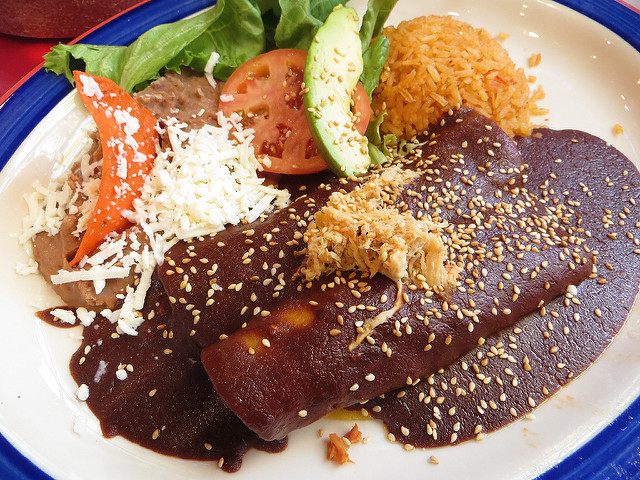The Incompatible Food Triad Is The Most Delicious Philosophical Problem Of Our Time
Academics have been trying to solve it for decades.

Mathematicians live out their days haunted by many questions. They may wake up some mornings already trying to prove the Hodge Conjecture. They may travel to work ruminating: Is every number greater than two truly the sum of three primes? And at the end of the day, they may drift off to sleep trying to figure out, once and for all, whether there are any odd perfect numbers.
But one problem, in particular, scourges them at dinner—that of the Incompatible Food Triad.
That conundrum goes like this: Can you think of three foods where any two of those foods taste good together, but all three combined taste disgusting?
Like so many long-lasting mathematical mysteries, this one is more difficult than it sounds. Thus far, it has stymied at least four generations of academics, who have not been able to come up with a group of foods that definitively fit the bill, nor a way to prove that it can’t be done. George Hart, an engineering professor and mathematical sculptor, has been chewing on the Incompatible Food Triad for 36 years. “Is there a theorem that says if a and b are good, and b and c are good, and a and c are good, then a and b and c must be good? That’s something that, on the face of it, seems reasonable,” he says. “But then when you look for an argument, a truth, you don’t find one.”

Try it for yourself: Think of two foods that you like, and then try to mess them up by adding a third. Then, divide them out again, checking each pair individually. Mentally testing combinations like this feels like chewing Willy Wonka’s three-course gum—you cruise through one food pair, and then the second, before the third turns you blue. Strawberries, chocolate, and brie? Strawberries and chocolate: delicious; strawberries and brie: a picnic classic; chocolate and brie: no way.
As far as the problem’s contemporary fans know, the Incompatible Food Triad was first pondered by Wilfrid Sellars, a University of Pittsburgh philosopher better known for his work with semantics. Sellars used to bring the problem up over dinner with his students and colleagues. One of these was Nuel Belnap, a logician, and when Belnap rose up in the ranks, he, too, made the Triad part of his dinner conversation. That’s where Hart first heard it, in the late 1970s, after which he also began pulling it out as a conversation starter.
It sparked some good debate—“It’s a natural thing to talk about,” Hart says. But, like a thread of spinach wedged high up in a molar, the lack of a clear solution continued to irritate him. He wanted more interlocutors. So, in August of 2003, he took the problem to the biggest dinner table of all time: the Internet. “Recently, at a wonderful dinner in southern Spain with a colleague, two graduate students, and a vast platter of tentacles and mysterious seafood, I realized it has been twenty-five years with zero progress,” he wrote. “…Better minds (or taste buds) than mine must now be brought to bear in this research.”

Something about the question hit a nerve—not just with mathematicians, but with the general public. Answers began trickling in, then pouring. Each had some shortcoming. Lemon, cocoa, and curry don’t sound great, but it’s not too hard to imagine a decent lemon mole sauce. Salted cucumbers, sugar, and yogurt might work, but if you count the salt, that’s four ingredients, not three. You might not like the thought of potatoes, mayonnaise and cabbage, but someone has invented a corned beef salad that has all three.
At first, Hart posted the answers as they came, with his own commentary. He even tried to get Google in on it, asking some employees whether it would be possible to trawl through recipes for food pairs, and then cross-reference sets of them to try to find an incompatible triad (sadly, they said it was impossible). But soon, Hart found himself overwhelmed by the task. He got erudite hate mail: “I am baffled, shattered, and destroyed by the mind-numbing pointlessness of the Incompatible Food Triad experiment,” one non-fan wrote in. “It makes me ill.” He got trolled: “Get pregnant, and you can eat anything!” insisted another.
Eventually, he heard from renowned French gastronomer Hervé This, who took umbrage with the whole premise. (“May I tell you that your question is wrong, and this is why there is no solution,” he wrote.) After that, Hart stopped adding responses altogether. “To have a world-renowned chef come and say, basically, ‘You can’t solve this’ was sort of a convenience for me, allowing me to put it away,” he says. (He also asked that Atlas Obscura beg any readers with possible solutions not to email him.)

But others have soldiered on. Reddit threads occasionally pop up, generate interest, and then die down again. Tiffany Inglis, a programmer and digital artist, took some time a few years ago to design a lemon affogato, in order to patently prove that a top Incompatible Food Triad contender—espresso, lemon, and milk—wasn’t so bad after all. Inglis has set her own bar for success: “If there exists a combination such that the trio, but none of the pairs, creates a toxic chemical reaction, then it would be a true impossible triad,” she says. “Until then, it’s just a fun mental exercise.”
Hart agrees. “Suppose someone had an empirical solution, an actual recipe—‘Put this together, taste them, it’s all good. Put all three together, it explodes, it turns blue, it’s awful!’—I think that would satisfy it in a beautifully clean way,” he says. “Oh, I would love it.” Until then, it’s just another endless, delicious argument on the Internet.
Update, 12/16: The original version of this article said that Wilfrid Sellars was a philosopher at Stanford—he actually spent the majority of his career at the University of Pittsburgh. Thanks to Shawn Standefer for the correction, and we regret the error.
Gastro Obscura covers the world’s most wondrous food and drink.
Sign up for our regular newsletter.

























Follow us on Twitter to get the latest on the world's hidden wonders.
Like us on Facebook to get the latest on the world's hidden wonders.
Follow us on Twitter Like us on Facebook